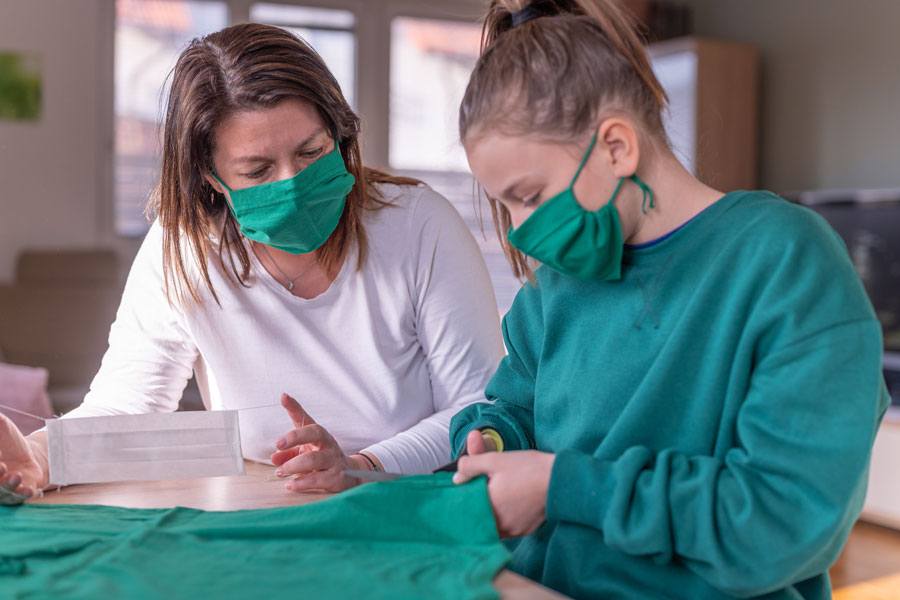Here’s What You Need to Know About the #Masks4All Debate
Plus, some resources for making your own mask.

Many people are wondering whether — and arguing that — we should all be wearing homemade face masks right now. Photograph by ti-ja/Getty Images
UPDATE: On April 3rd, the CDC updated their guidelines to recommend that all wear cloth face coverings in public settings. Learn more about the CDC’s recommendations here.
The question of whether or not healthy and/or non-symptomatic individuals should be wearing masks of some sort whenever they must leave their homes for essential purposes is on a lot of people’s minds. Unfortunately, it doesn’t have an easy answer at the moment. Why? Because the CDC has not provided one — though recent reports have come out that they’re working toward new guidelines.
When the coronavirus outbreak first started picking up in America, the CDC provided guidelines stating that anyone who is sick should wear a mask around other people. But for those who are not sick, the CDC stated, “You do not need to wear a facemask unless you are caring for someone who is sick (and they are not able to wear a facemask). Facemasks may be in short supply and they should be saved for caregivers.”
Given the massive personal protective equipment shortage in America, it makes sense that officials are concerned about a run on masks (particularly the medical-grade N95 variety) — something that was beginning to happen back in January causing officials to plead with the public to stop buying masks.
But a new movement — anchored by the hashtag #Masks4All and promoted by articles published recently in the Washington Post and the New York Times, which base their cases on studies showing the effectiveness of masks against the spread of influenza and respiratory illnesses and on the universal mask-wearing in other places, like Hong Kong and, recently, Central Europe — argues that actually everyone should be wearing masks of some kind.
In summary, the thinking is this: While a mask might not protect you from getting infected, it could help prevent you from spreading the virus. And while masks are currently only recommended by the CDC for those who are sick, it’s been shown that asymptomatic people can shed the virus. Therefore, it makes sense that if even homemade masks can indeed help contain the viral spread, if everyone wore masks, we’d lower the risk of seemingly healthy people spreading the coronavirus. And as for the mask shortage? People can make their own at home, thereby not taking away from the limited supply of medical-grade masks that health care workers rely on.
While the points presented by the #Masks4All proponents are certainly compelling, the CDC has yet to change its recommendations about who should be wearing masks — though they are considering changing those guidelines. On Monday, when NPR asked CDC director Dr. Robert Redfield about the potential update to these guidelines, he said:
Particularly with the new data, that there’s significant asymptomatic transmission, this is being critically re-reviewed to see if there’s potential additional value for individuals that are infected or individuals that may be asymptomatically infected. … I can tell you that the data and this issue of whether it’s going to contribute [to prevention] is being aggressively reviewed as we speak.
While the question of whether or not all should be wearing masks in public is an ongoing debate, we should hopefully have better direction from the CDC soon, as the Trump administration has announced that new guidelines will be released by the CDC in the coming days.
In the meantime, there are plenty of resources online for both buying masks made at home by others or learning to make them yourself. Some things to keep in mind, however, if you’re going the cloth route: considering that medical-grade face masks are supposed to be discarded after each use (though the shortage has seen much more reuse of these masks), you should wash your homemade mask frequently (though we still don’t know how long the virus can live on fabric).
Obviously, the very best way to stop the spread of coronavirus is to stay at home and to practice social distancing anytime you absolutely must go out. But if you’re looking for a homemade mask to wear on top of these measures, here are some resources that can help:
Sew Face Masks Philly
This local group is working to sew masks for all. They’re both accepting mask donations to redistribute to those who need them, as well as taking requests from organizations and individuals who need masks.
Adult Face Mask Sewing Pattern
Local retailer Butcher’s Sew Shop is providing this downloadable PDF template for making your face mask at home, and asking for a $3 donation to help their small business at this time.
How to Sew a Face Mask
The New York Times lays out step-by-step instructions (with illustrations!) for making your mask at home.
How to Make a Dust Mask out of a T-Shirt
Can’t sew? Don’t have a needle and thread? All you need to follow this YouTube tutorial is a t-shirt and a pair of scissors.


